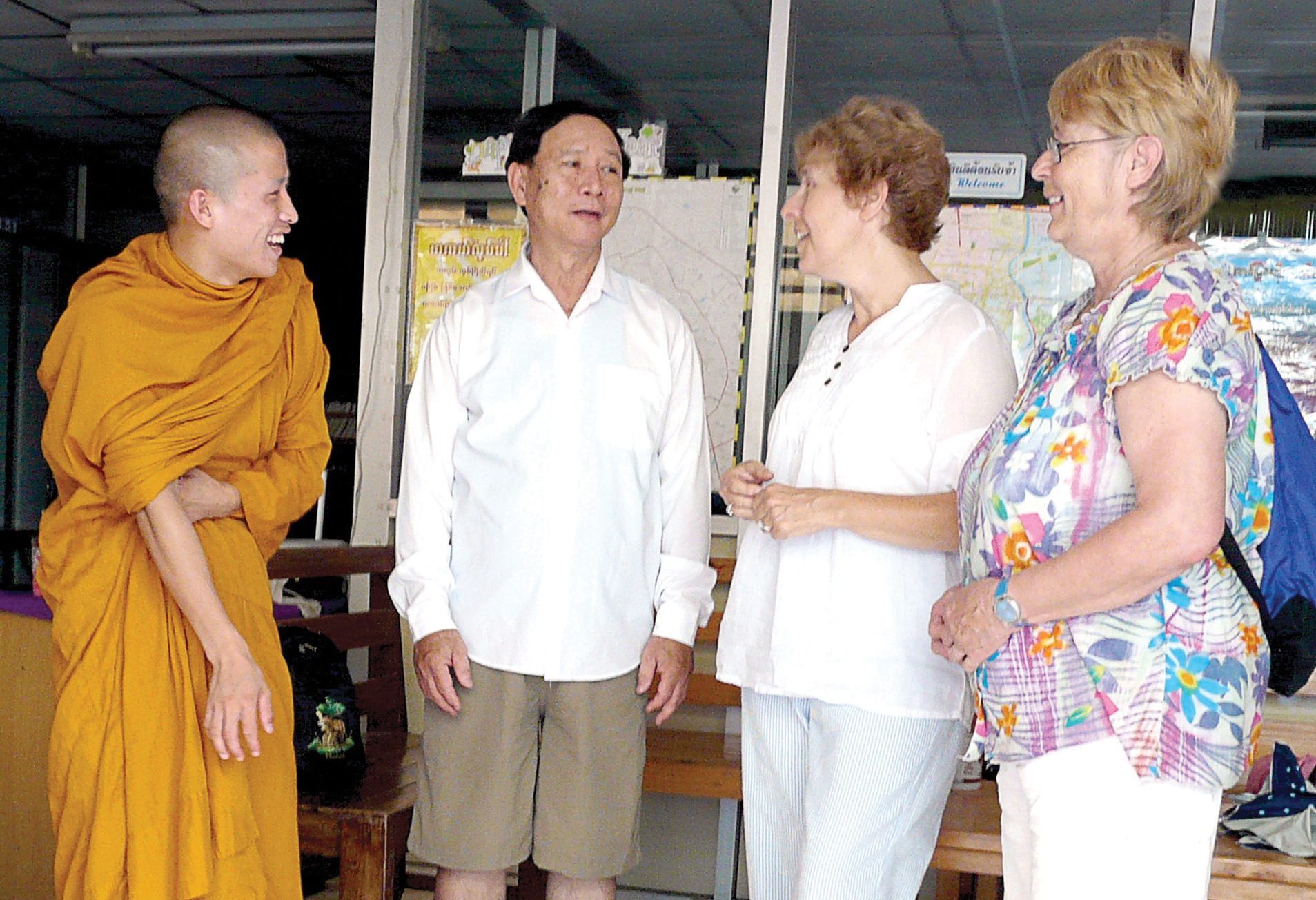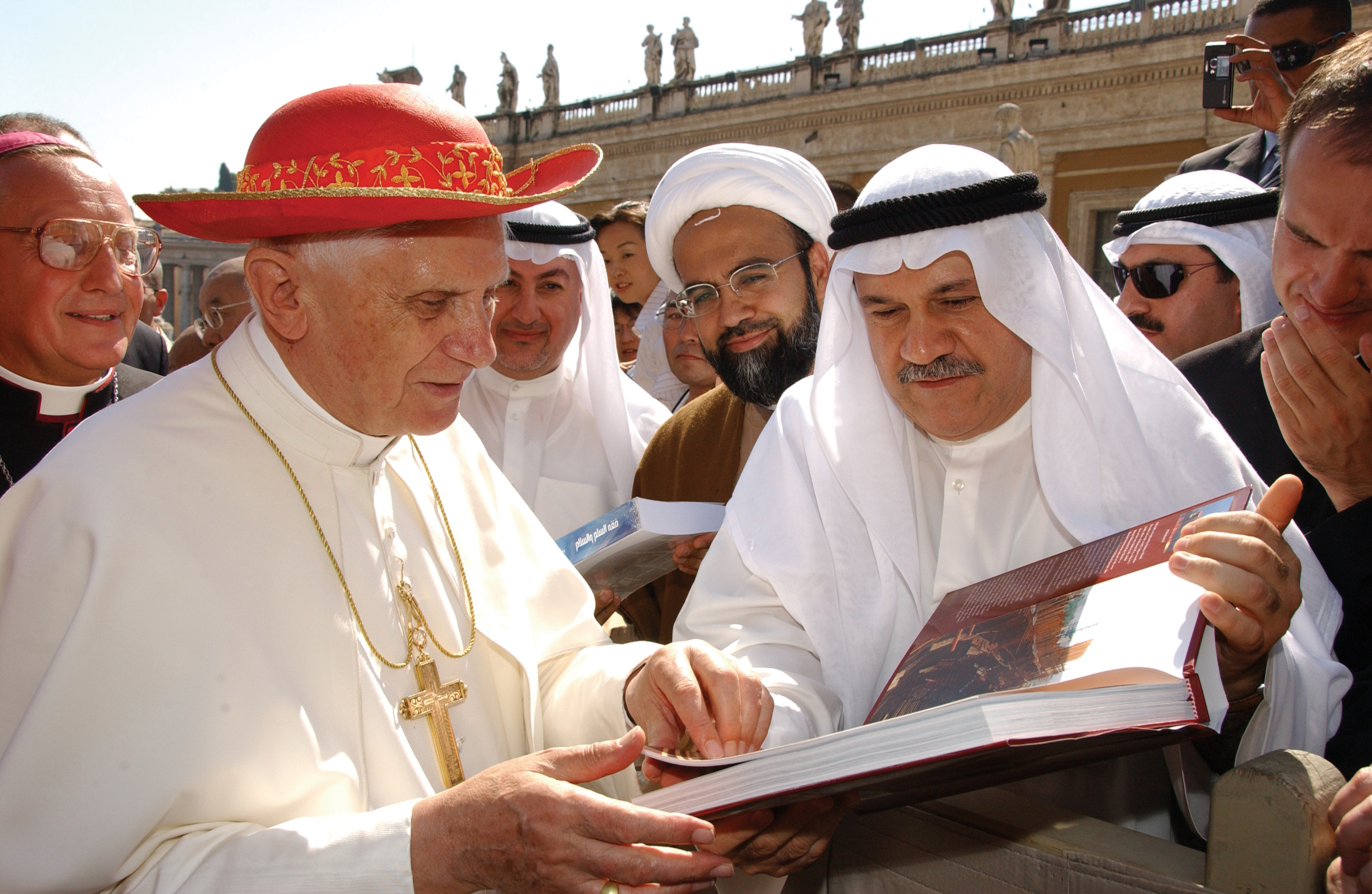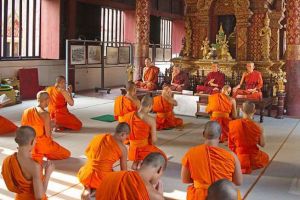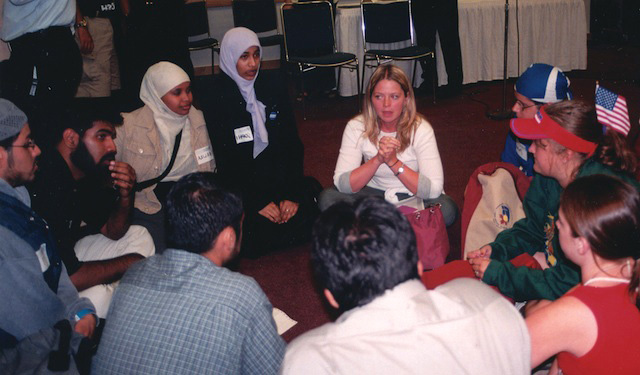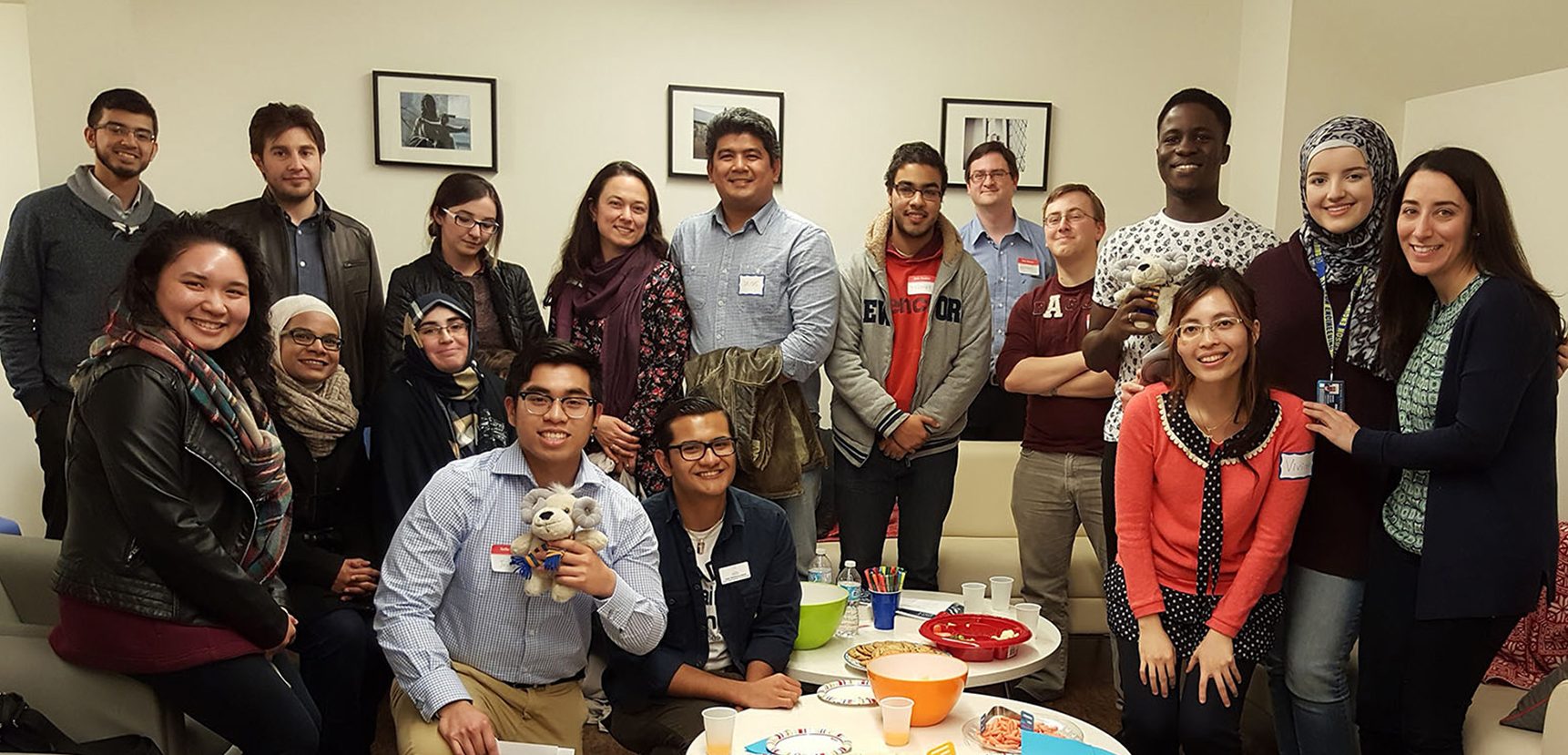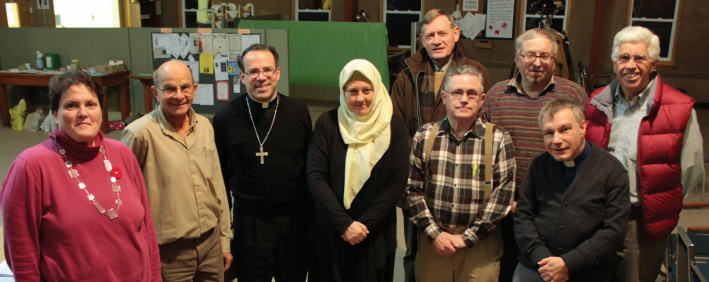This collection of resources chronicles the Catholic Church’s journey of dialogue with other religions, a journey that began with the Second Vatican Council of the 1960s. Featured here are interfaith stories, theological reflections, and official Vatican documents. Also included are photos and articles detailing the interfaith journey of Scarboro Missions.
The Second Vatican Council
In the last four decades, Catholics and Protestants have been seriously rethinking their attitudes towards non-Christian religions. And the Second Vatican Council is now seen as a watershed event in this new openness toward Jews, Muslims, Buddhists, Hindus, Aboriginals and others. Indeed, the Church has come to recognize and respect the presence of grace, truth and holiness in other religions. But more than this, the Church realizes it stands to benefit from dialogue with other spiritual traditions. This conviction is best capsulized in the words of John Paul II: "By dialogue, we let God be present in our midst, for as we open ourselves to one another, we open ourselves to God."
The Council produced ground-breaking documents on religious pluralism, interfaith dialogue and religious liberty. The key Council documents relevant to interfaith are:
- The Declaration on the Relationship of the Church to Non-Christian Religions
- The Declaration on Religious Freedom
- The Pastoral Constitution on the Church in the Modern World
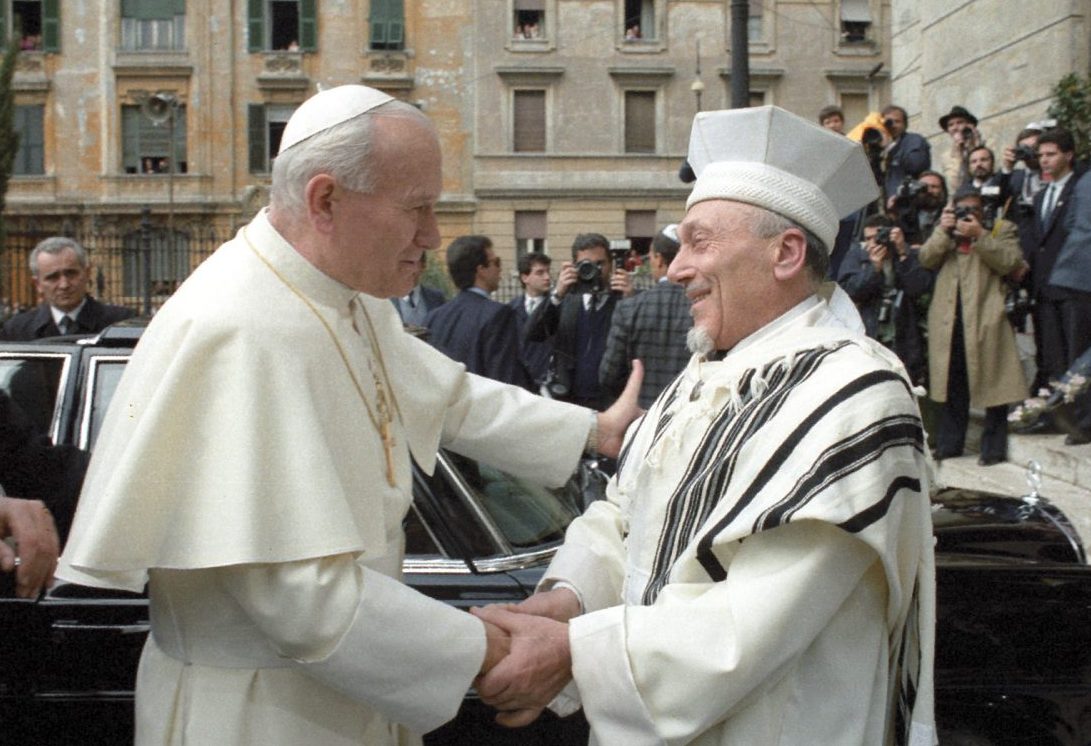
Rome’s Chief Rabbi – Elio Toaff – welcomes John Paul II; the first papal visit to Rome’s Grand Synagogue. 1986
Popes Lead the Way
This article profiles the courageous interfaith initiatives of the last four popes as the Church journeys through the uncharted territory of interfaith dialogue. What is particularly striking here are the interfaith breakthroughs engineered by Pope John Paul II. Read this article from the Jan-Feb 2007 issue "Popes lead the way"
John Paul II–Interfaith Giant
John Paul II was one of the most influential interfaith figures of the twentieth century. His commitment to dialogue, his extensive global travel and his acute awareness of our interdependent lives in the global village made him a significant force in the international interfaith movement. This article offers a chronological profile of the interfaith journey of Pope John Paul II from his election to the papacy in 1978 until his death in 2005. To read article, click here.
Pontifical Council for Interreligious Dialogue
Since Vatican II, an explosion of interfaith activity has occurred within the international Catholic community and at all levels of Church, including lay people, teachers, academics, social activists, monks, missioners, priests, bishops and popes. In 1964, Pope Paul VI began building a Catholic infrastructure to nourish his dream of a Church in conversation with other religions and cultures. This organization, known as the Pontifical Council for Interreligious Dialogue, is active on an international level and has the following goals:
- to promote mutual understanding, respect and collaboration between Catholics and the followers of other religious traditions;
- to encourage the study of world religions;
- to promote the formation of persons dedicated to interfaith dialogue.
To visit the Council's website, click here
Official Church Documents on Interfaith Dialogue
This listing features official Church documents on interfaith dialogue that have been published during and since the era of the Second Vatican Council. Included here are papal encyclicals as well as documents produced by the Pontifical Council for Interreligious Dialogue, by Bishops' Conferences and by Congregations within the Vatican (e.g. the Congregation for the Doctrine of the Faith). To read listing, click here.
Catholicism and Other Faiths
In this short but poignant article, Canadian dialogue theologian, Fr. Ovey N. Mohammed S.J., outlines the Catholic Church's evolving historical stance toward other religions. Before the Second Vatican Council of the 1960s, the Church's attitude toward other religions was negative. Since the Council, the Church's attitude has become much more positive and embracing. Mohammed describes this vital shift and comments on the interfaith challenges faced by modern Catholics. To read article, click here
Interfaith Dialogue: An interview with Ovey. N. Mohammed S.J.
In this interview, Canadian dialogue theologian, Fr. Ovey N. Mohammed S.J., explores the many challenging issues faced by Christians in interfaith dialogue, challenges that include pluralism, diversity, multiculturalism, global consciousness and related pastoral issues. To read interview, click here
Milestones in Recent Catholic-Jewish Relations
This document chronicles, on a year-by-year basis, the dramatic advances in Catholic-Jewish dialogue since the Second Vatican Council. This detailed profile of significant changes and developments in Catholic-Jewish relations will be very useful to teachers, students, researchers, historians, interfaith practicioners and others. This document can be downloaded free of charge and is available in English and French.
Commission of the Holy See for Religious Relations with the Jews
This important Vatican Commission promotes enhanced relations between the Church and Judaism. The Commission's website outlines the history of the commission and contains links to numerous official documents produced by the Church and the international Jewish community. To visit the website, click here.
Texts of Scarboro Interfaith lectures – the Abrahamic Faiths
In 2016, Scarboro Missions sponsored four interfaith lectures. Three of these explored the concept of Mercy from Jewish, Christian and Muslim perspectives. The fourth talk focused on Jewish and Christian responses to an important 2015 Vatican document on Jewish-Catholic relations. The texts of all the talks can be accessed below:
Christian perspectives on Mercy – Dr. Murray Watson
Jewish perspectives on Mercy – Rabbi Ed Elkin
Muslim perspectives on Mercy – Imam Dr. Hamid Slimi
A Jewish and Catholic response to the New Vatican Document on Catholic-Jewish Relations – “The Gifts and Calling of God are Irrevocable” (Rom. 11:29)
Rabbi Baruch Frydman-Kohl
Dr. Eileen Schuller OSU
Jewish-Christian Capsule Biographies
Featured here are biographies of 30 leaders in the field of Jewish-Christian dialogue – 15 of the individuals profiled are Jewish and 15 are Christian. The biographies feature “pioneers” who were highly active during the Vatican II period as well those who are contemporary voices.
http://www.notredamedesion.org/en/page.php?id=121&T=3
http://www.notredamedesion.org/en/page.php?id=122&T=3
Muslim-Christian Dialogue
Together, Muslims and Christians form 50 percent of the world’s population. In this article, Canadian dialogue theologian, Fr. Ovey Mohammed S.J., examines the history of the relationship between these two major religions. Mohammed also explores the new levels of cooperation between Islam and Christianity that have occurred since the Second Vatican Council of the 1960s. Read more ...
Muslims and Christians in conversation
In 2013, Scarboro Missions teamed up with an Islamic Education Center in Toronto for four successful evenings of small-group Muslim-Christian dialogue. To read more:
http://www.scarboromissions.ca/Scarboro_missions_magazine/Issues/2014/Jan_Feb/conversation.php
International Conference of Muslims, Christians and Jews in Turkey
In the summer of 2010, Sr. Lucy Thorson NDS, of the Scarboro Missions Interfaith Department, attended the annual conference of the International Conference of Christians and Jews (ICCJ) which took place in Istanbul, Turkey. Muslims were also invited to participate in and present seminars at the conference. To read Sr. Thorson's report on the gathering, click here
Hindu-Catholic dialogue in Canada -- a photo-essay
Together, Hindus and Christians form approximately 45% of the world’s population. The Hindu-Christian conversation has been happening for decades. The Catholic-Hindu Dialogue of Canada has published a photo-essay which provides an overview of its dialogue meetings, its members, as well as its goals and aims. This dialogue is co-sponsored by the Canadian Conference of Catholic Bishops and Hindu delegates from the Hindu Federation of Canada, the International Society of Krishna Consciousness and other Hindu communities. You can view or download this photo-essay in English and French:
English: https://www.cccb.ca/wp-content/uploads/2019/07/Hindu-Catholic_Dialogue_-_Final_English.pdf
French: https://www.cccb.ca/wp-content/uploads/2019/07/Hindu-Catholic_Dialogue_-_Final_French.pdf
The Committee for Ecumenical and Interreligious Affairs -- United States Conference of Catholic Bishops
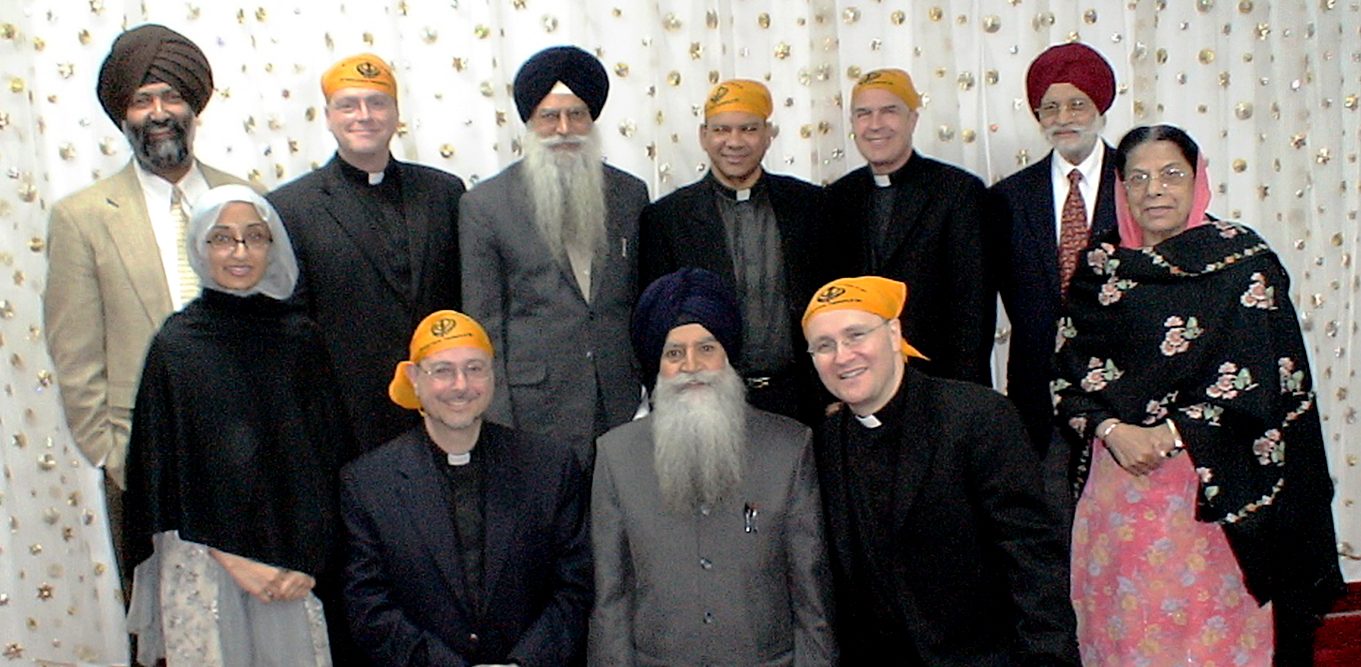
US Bishops and the World Sikh Council (America Region) meet in New York for the first Catholic-Sikh national consultation in US history. (2006) The Vatican was represented by Monsignor Felix Machado (third from right, back row), Under-Secretary of the Pontifical Council for Interreligious Dialogue. Visitors to a Sikh temple must remove their shoes and wear a head covering as a sign of respect for God.
This committee of bishops and ecumenical experts promotes the ecumenical and interfaith efforts of the Catholic Church in the United States. The committee's website contains a wealth of resources as well as numerous links to important documents featuring the Catholic Church's dialogue with other religions in the United States and around the world. To visit the website, click here.
Assisi Decalogue for Peace
During the interfaith prayer service at Assisi (2002), ten of the 200 faith representatives each read one of the following ten commitments in their own language. In March, Pope John Paul II sent a copy of the Decalogue for Peace to all heads of state. In an accompanying letter, the Pope stated that the participants at the Assisi gathering were inspired more than ever by one common conviction — humanity must choose between love and hatred.

Pope John Paul II convenes an historic gathering of religious leaders in Assisi to pray for peace. 1986 Credit: L'Osservatore Romano
- We commit ourselves to proclaiming our firm conviction that violence and terrorism are opposed to all true religious spirit and we condemn all recourse to violence and war in the name of God or religion. We undertake to do everything possible to eradicate the causes of terrorism.
- We commit ourselves to educate people about respect and mutual esteem in order to achieve peaceful coexistence and solidarity among members of different ethnic groups, cultures and religions.
- We commit ourselves to promote the culture of dialogue so that understanding and trust may develop among individuals and peoples as these are the conditions of authentic peace.
- We commit ourselves to defend the right of all human beings to lead a dignified life, in accordance with their cultural identity.
- We commit ourselves to engage in dialogue with sincerity and patience, without considering what separates us as an insurmountable wall, on the contrary, recognizing that facing our differences can become an occasion for greater reciprocal understanding.
- We commit ourselves to pardon each other's errors and prejudices of the past and present, and to support one another in the common struggle against egoism and abuses, hatred and violence, and in order to learn from the past that peace without justice is not true peace.
- We commit ourselves to stand at the side of those who suffer poverty and abandonment, speaking out for those who have no voice and taking concrete action to overcome such situations, in the conviction that no one can be happy alone.
- We commit ourselves to make our own the cry of those who do not surrender to violence and evil, and we wish to contribute with all our strength to give a real hope of justice and peace to the humanity of our time.
- We commit ourselves to encourage all initiatives that promote friendship between peoples, in the conviction that, if a solid understanding between peoples is lacking, technological progress exposes the world to increasing dangers of destruction and death.
- We commit ourselves to ask the leaders of nations to make every possible effort so as to build, at both national and international levels, a world of solidarity and peace founded on justice.
Christian Witness in a Multi-Religious World
In 2011, this 5-page document was jointly published by the the Pontifical Council for Interreligious Dialogue (Vatican), the World Council of Churches and the World Evangelical Alliance. Together, these bodies represent 90 percent of the world’s Christians. The purpose of the document is to address practical issues associated with Christian witness in a multi-religious world. The document encourages churches, church councils and mission agencies to reflect on their current practices and to use the recommendations in the document to prepare their own guidelines for their witness and mission among peoples of different religions and among those who do not profess any particular religion. To read or download the entire document, click here.
How do Christians understand other religions?
In an excellent paper entitled, Thinking Theologically about Other Religions: Christian Theologies of Religions, American theologian, David R. Brockman, does two things. He, first of all, surveys Church history to enlighten us as to how Christians have addressed the issue of other religions in the past; and, second, he provides a wonderful outline of how modern Christian theologians are wrestling with this challenging question. To view or download this paper, click here.
Four Levels of Interfaith Dialogue
In 1984, the Vatican's Secretariat for Non-Christians issued a document entitled The Attitude of the Church towards the Followers of Other Religions (Reflections and Orientations on Dialogue and Mission). The document described interrreligious dialogue in this way:
"It [dialogue] means not only discussion, but also includes all positive and constructive interreligious relations with individuals and communities of other faiths which are directed at mutual understanding and enrichment."
Dialogue and Mission identifies four levels of inter-religious dialogue:
- the dialogue of life where Christians and others live together in a neighbourly spirit, sharing their joys and sorrows, their problems, and their preoccupations with one another;
- the dialogue of deeds where Christians and others work together in the pursuit of humanitarian, social, economic, or political goals;
- the dialogue of theological exchange where specialists deepen their understanding of each other's spiritual values;
- the dialogue of religious experience where Christians and others share with each other their experiences of searching for the Absolute.
Poster Featuring Recent Catholic Milestones in Interfaith Dialogue (free online)
This attractive poster features key milestones in the Catholic Church's interfaith journey from the Second Vatican Council to the present. To view or download free of charge, click here
Special Interfaith Editions of Scarboro Missions Magazine
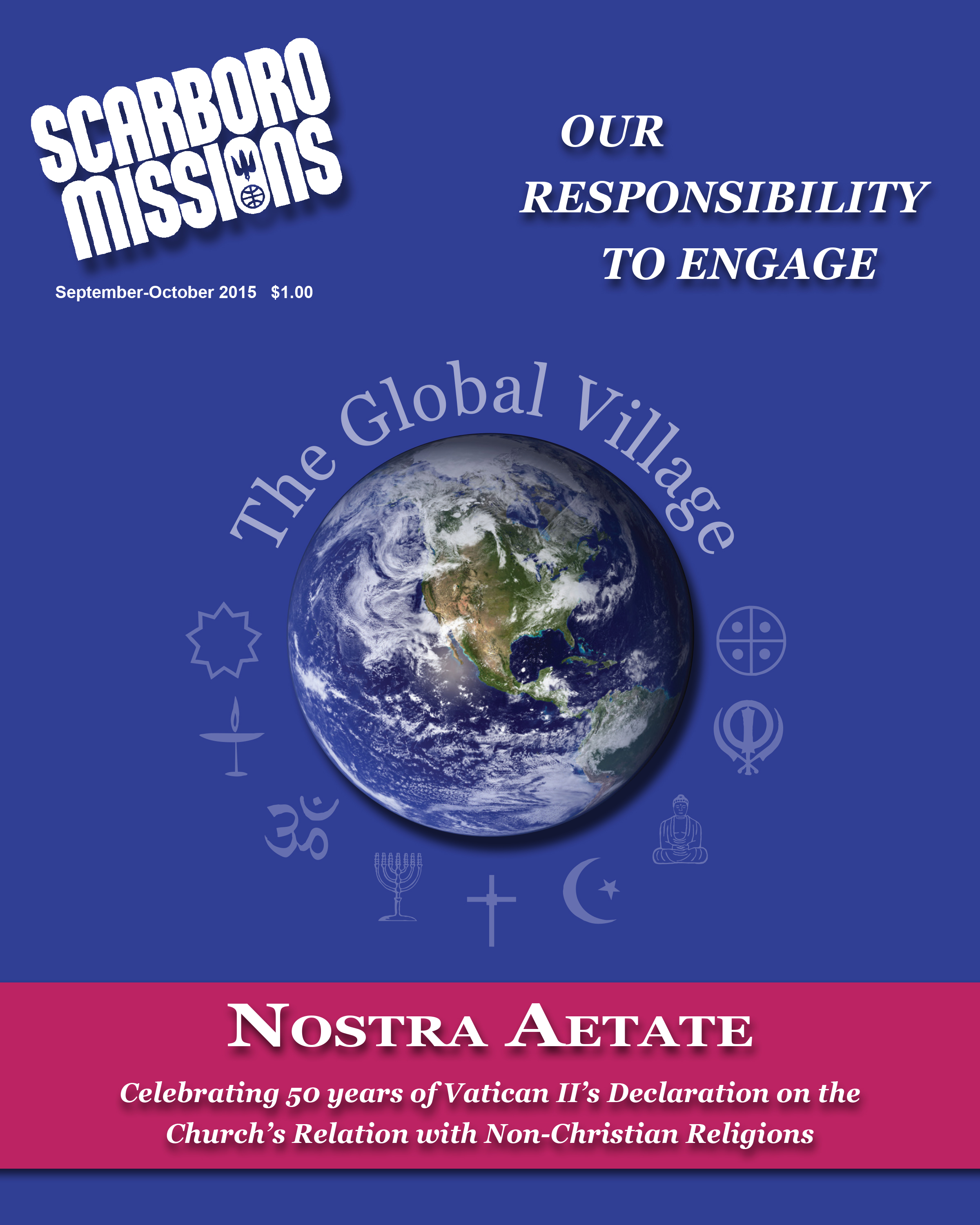 Below please find links to various interfaith editions of Scarboro magazine. These magazine issues chronicle growing Catholic involvement in interfaith work around the world, a development that began with the Second Vatican Council of the 1960s. Also featured here are papal interfaith initiatives as well as the interfaith work of Scarboro Missions.
Below please find links to various interfaith editions of Scarboro magazine. These magazine issues chronicle growing Catholic involvement in interfaith work around the world, a development that began with the Second Vatican Council of the 1960s. Also featured here are papal interfaith initiatives as well as the interfaith work of Scarboro Missions.
Our Responsibility to Engage: 50 years of Nostra Aetate
http://www.scarboromissions.ca/document/september-october-2015
Building a global interfaith community
http://www.scarboromissions.ca/Scarboro_missions_magazine/Issues/2007/Jan_Feb/contents.php
Interfaith dialogue – A golden conversation
http://www.scarboromissions.ca/Scarboro_missions_magazine/Issues/2005/January_February/contents.php
Counting interfaith miracles (September 2002)
http://www.scarboromissions.ca/Scarboro_missions_magazine/Issues/2002/September/contents.php
The Interfaith Conversation
http://www.scarboromissions.ca/Scarboro_missions_magazine/Issues/2001/September/contents.php
Interfaith Dialogue
http://www.scarboromissions.ca/Scarboro_missions_magazine/Issues/2000/Jan_Feb/contents.php
Interfaith Dialogue Organizations – Four Directories
These four directories feature interfaith organizations in various part of the world. As you make your way through these directories, you will see the dramatic growth of the international interfaith movement as well as an abundance of Catholic interfaith activity:
- Italy – features close to 100 interfaith organizations
https://www.scarboromissions.ca/wp-content/uploads/2017/02/IFI.pdf - French-speaking countries – 38 countries are profiled
https://www.scarboromissions.ca/wp-content/uploads/2017/02/IIF.pdf - Vatican directory – features Catholic interfaith agencies in 90 countries
https://www.scarboromissions.ca/wp-content/uploads/2017/02/IFV.pdf - Spanish-speaking countries – 20 countries are featured
https://www.scarboromissions.ca/wp-content/uploads/2017/02/Spanish-interfaith-directory-2017.pdf
Interfaith Articles – Scarboro Missions Magazine
- Interfaith Dialogue Encouraged Feb/98
- A Commitment to Dialogue Feb/98
- In Conversation with Muslims Feb/98
- In Conversation with Buddhists Feb/98
- Mother Teresa—Interfaith Ambassador Feb/98
- Opening Ourselves To God... Interfaith Dialogue Feb/99
- Canada: A Multicultural Nation Dec/96
- Interfaith Dialogue: Interview with Ovey Mohammed, SJ May/90
- Catholicism & Other Faiths Oct/90
- Judaism Feb/94
- Gandhi: Soldier of Nonviolence Apr/95
- Gandhi & Christian Mission Apr/96
- Understanding Hinduism Oct/90
- Muslim-Christian Dialogue Oct/94
- Understanding Buddhism Apr/91
- Aboriginal Spirituality Apr/93
- The Jain Religion Apr/97
- Understanding the Baha'i Faith Apr/97
- The Unitarian Faith Apr/97
Questions or Concerns?
Contact:
Paul McKenna | interfaithgold@gmail.com |


